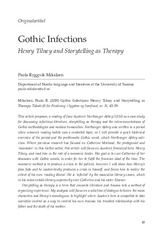Jonathan, Mina and the Holiest Love: Intimations of a Virtuous Queerness in Dracula (1897)
| dc.contributor.advisor | Castor, Laura Virginia | |
| dc.contributor.author | Hessen, Viktor Karlsen | |
| dc.date.accessioned | 2024-07-09T19:43:31Z | |
| dc.date.available | 2024-07-09T19:43:31Z | |
| dc.date.issued | 2024-05-15 | |
| dc.description.abstract | The first few chapters of Bram Stoker’s Gothic thriller Dracula (1897) conform closely to the classic Gothic narrative of imperiled heroine and menacing Gothic villain, except that the role of young, imprisoned ingénue goes to the male Jonathan Harker. The subversion of genre-based gender expectations introduced by the dissonance between the character and his role introduces a theme of transgressive gender performance and sexuality which permeates the entire novel. Drawing on gender theorist Judith Butler, this thesis argues that protagonists Jonathan and Mina Harker display a degree of gender non-conformity by contemporary standards. Gadamer’s hermeneutics provide a framework for historical inquiry as Dracula is situated in two vital contexts, namely the socio-political context of Stoker’s literary production as well as the Gothic tradition. The formulaic nature of Gothic plots provides a way to suggest the possibility of queerness without needing to name it. While the sexual transgression of the novel’s vampire characters is made obvious through their vampiric anatomy and eroticized behavior, the contextual transgression of characters like Jonathan and Mina Harker relies on pattern recognition. The Harkers are presented as a viable alternative to overt vampiric transgression and conservative Victorian gender roles alike, and their queer traits are in many ways presented as virtuous. | en_US |
| dc.identifier.uri | https://hdl.handle.net/10037/34125 | |
| dc.language.iso | eng | en_US |
| dc.publisher | UiT Norges arktiske universitet | en_US |
| dc.publisher | UiT The Arctic University of Norway | en_US |
| dc.rights.accessRights | openAccess | en_US |
| dc.rights.holder | Copyright 2024 The Author(s) | |
| dc.rights.uri | https://creativecommons.org/licenses/by-nc-sa/4.0 | en_US |
| dc.rights | Attribution-NonCommercial-ShareAlike 4.0 International (CC BY-NC-SA 4.0) | en_US |
| dc.subject.courseID | ENG-3992 | |
| dc.subject | Dracula | en_US |
| dc.subject | The Gothic | en_US |
| dc.subject | gender studies | en_US |
| dc.subject | queer studies | en_US |
| dc.subject | queer Gothic | en_US |
| dc.subject | Victorian studies | en_US |
| dc.subject | Bram Stoker | en_US |
| dc.subject | fin de siècle | en_US |
| dc.subject | Gothic | en_US |
| dc.subject | 19th century Gothic | en_US |
| dc.subject | Radcliffean Gothic | en_US |
| dc.subject | female Gothic | en_US |
| dc.subject | Ann Radcliffe | en_US |
| dc.subject | Jonathan Harker | en_US |
| dc.subject | Mina Murray | en_US |
| dc.subject | Mina Harker | en_US |
| dc.subject | Victorian masculinity | en_US |
| dc.subject | Gothic masculinity | en_US |
| dc.title | Jonathan, Mina and the Holiest Love: Intimations of a Virtuous Queerness in Dracula (1897) | en_US |
| dc.type | Master thesis | en_US |
| dc.type | Mastergradsoppgave | en_US |


 English
English norsk
norsk



